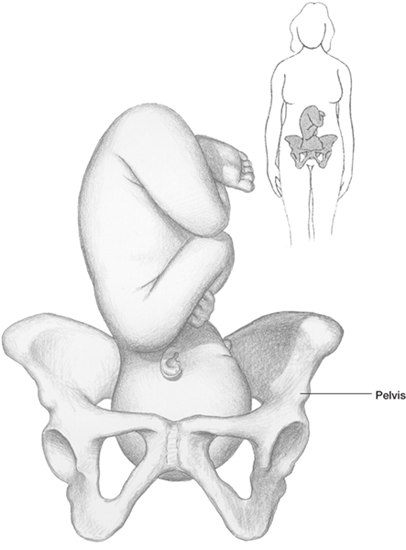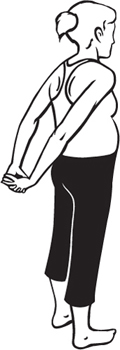Packing for the Hospital
Packing for the hospital can be
unnerving. You don’t want to pack too early and have your suitcase
staring at you. But you don’t want to wait till the last minute, throw
your things together and take the chance of forgetting something
important.
It’s probably a good idea to pack about 3
or 4 weeks before your due date. Pack things you’ll need during labor
for you and your labor coach, items you and the baby will need after
delivery and personal articles for your hospital stay. There are a lot
of things to consider, but the list below should cover nearly all of
what you might need:
• completed insurance or preregistration forms and insurance card
• heavy socks to wear in the delivery room
• an item to use as a focal point
• 1 cotton nightgown or T-shirt for labor

Alignment of baby with head in pelvis before delivery.
This is the preferable presentation.
• lip balm, lollipops or fruit drops, to use during labor
• light diversion, such as books or magazines, to use during labor
• breath spray
• 1 or 2 nightgowns for after labor (bring a nursing gown if you’re going to breastfeed)
• slippers with rubber soles
• 1 long robe for walking in the halls
• 2 bras (nursing bras if you breastfeed)
• breast pads for leaking breasts
• 3 pairs of panties
• toiletries you use, including brush, comb, toothbrush, toothpaste, soap, shampoo, conditioner
• hairband or ponytail holder, if you have long hair
• loose-fitting clothes for going home
• sanitary pads, if the hospital doesn’t supply them
• glasses, if you wear contacts (you can’t wear contacts during labor)
You may also want to bring one or two pieces of fruit to eat after the delivery. Don’t pack them too early!
It’s a good idea to include some things
in your hospital kit for your partner or labor coach to help you both
during the birth. You might bring the following:
• a watch with a second hand
• talc or cornstarch for massaging you during labor
• a paint roller or tennis ball for giving you a low-back massage during labor
• tapes or CDs and a player, or a radio to play during labor
• a camera
• list of telephone numbers and a long-distance calling card
• change for vending machines
• snacks for your partner or labor coach
The hospital will probably supply most of what you need for baby, but you should have a few things:
• clothes for the trip home, including an undershirt, sleeper, outer clothes (a hat if it’s cold outside)
• a couple of baby blankets
• diapers, if your hospital doesn’t supply them
Be sure you have an approved
infant car seat for baby’s first ride. It’s important to put your baby
in a car seat the very first time he or she rides in a car! Many
hospitals won’t let you take your baby home without one.
What You May See in the Delivery Room
You’ll see lots of equipment when you
enter the labor and/or delivery room. You won’t recognize most of it,
so we include descriptions of equipment you may encounter.
An electronic vital-signs monitor
measures your heart rate and blood pressure with a cuff. It tells
doctor how well you and baby are doing. I.V. infusion pumps deliver
fluids into your veins if the doctor orders them.
There are many types of birthing beds. In
many, the bottom section can be removed, converting the bed into a
delivery table. Some beds can also accommodate alternate birthing
positions.
An epidural pump delivers pain-relief
medication after the epidural catheter is put in place by an
anesthesiologist. A vacuum extractor helps baby through the birth canal
in some cases. An amniohook looks like a crochet hook; it’s used to
rupture membranes.
Suction bulbs are used to draw blood and
mucus from baby’s nose and mouth after birth and in the days after
delivery. An infant warmer helps stabilize baby’s temperature. An
infant scale weighs him or her.
Women who listen to lyric-free,
instrumental music (synthesizer, harp, piano, orchestra or jazz) for 3
hours during early phases of active labor experience less pain and
distress. We believe the slow music helps a woman relax and distracts
her from her pain.
 Fetal Monitoring
Fetal Monitoring
A fetal monitor detects baby’s heart
rate and contractions, and can be used to track baby’s response to
them. It shows contractions and baby’s heartbeat; the readout is seen
in the labor room, nurses’ station and possibly on your doctor’s
computer.
Each baby needs to
be evaluated individually using fetal monitor tracing and other
information about your pregnancy. ACOG recommends the use of three
categories to describe the results of fetal monitoring.
• Category I—Tracings are normal.
• Category II—Tracings are
indeterminate; this means they aren’t normal, but they aren’t
absolutely abnormal. They require evaluation, continued surveillance
and re-evaluation. Eighty percent of all tracings fall into this
category.
• Category III—Tracings are
abnormal and require prompt evaluation. Elements used to categorize
them include fetal heart rate, variability, decelerations and reaction
to contractions.
9. Exercise for Week 36
To help improve your posture, stand or
sit on the floor, and clasp your hands behind you. Lift your arms until
you feel a good stretch in your upper-chest area and upper arms. Hold
for a count of 5, then lower your arms. Repeat 8 times. Stretches arm and back muscles, and opens upper chest.
